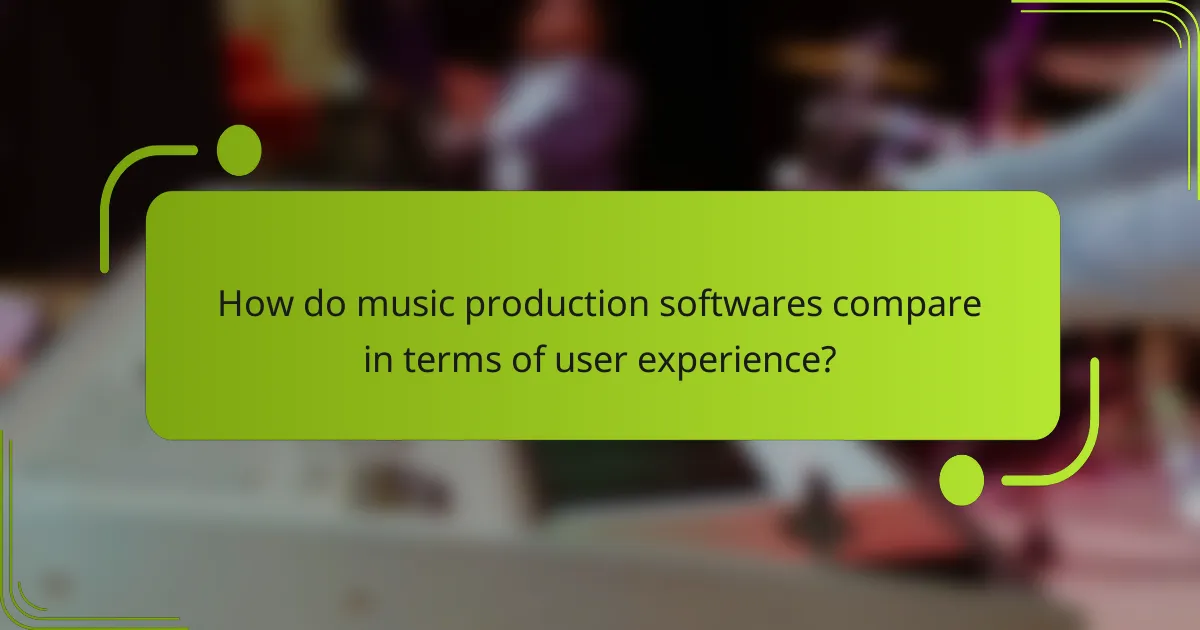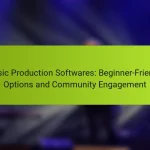Choosing the right music production software with an intuitive interface can significantly enhance your creative workflow. These programs are designed to simplify the process of composing, recording, and editing music, making them ideal for both beginners and seasoned producers. By prioritizing user-friendly layouts and essential features, you can focus on your creativity without the frustration of a steep learning curve.

What are the best music production softwares with intuitive interfaces?
The best music production softwares with intuitive interfaces are designed to streamline the creative process, making it easier for users to compose, record, and edit music. These tools often feature user-friendly layouts, drag-and-drop functionality, and customizable options that cater to both beginners and experienced producers.
Logic Pro X
Logic Pro X is a powerful digital audio workstation (DAW) favored by many music producers for its intuitive interface and comprehensive features. It offers a range of virtual instruments, effects, and loops, allowing users to create professional-quality music with ease.
The layout is straightforward, with a clean design that makes navigation simple. Users can quickly access their projects, mix tracks, and apply effects without feeling overwhelmed by complexity.
FL Studio
FL Studio is known for its user-friendly interface, especially for electronic music producers. Its pattern-based workflow allows users to create beats and melodies quickly, making it accessible for beginners while still offering advanced features for seasoned professionals.
The drag-and-drop functionality simplifies the process of arranging and editing audio clips. Additionally, the step sequencer and piano roll are designed to be intuitive, enabling users to focus on creativity rather than technicalities.
Ableton Live
Ableton Live stands out for its unique session view, which allows for flexible live performances and easy arrangement of musical ideas. The interface is designed to encourage experimentation, making it ideal for improvisation and live sets.
Users appreciate the simplicity of dragging audio and MIDI clips into the session view, which facilitates quick changes and adjustments. The software also includes a variety of built-in instruments and effects that are easy to navigate.
GarageBand
GarageBand is an excellent entry-level DAW for Mac users, offering an intuitive interface that is perfect for beginners. It provides a range of virtual instruments and loops, making it easy to start creating music without extensive technical knowledge.
The layout is clean and straightforward, allowing users to record, edit, and mix tracks with minimal effort. GarageBand’s simplicity does not compromise its capabilities, as it still offers powerful features for music production.
Studio One
Studio One is recognized for its drag-and-drop functionality and streamlined workflow, making it a favorite among many music producers. The interface is designed to be intuitive, allowing users to easily navigate through projects and access various tools.
With features like the single-window workspace and customizable shortcuts, Studio One enhances productivity. Its robust mixing capabilities and built-in effects are easily accessible, catering to both novice and experienced users alike.

How do I choose music production software for beginners?
To choose music production software for beginners, focus on intuitive interfaces that simplify the learning process. Look for programs that balance functionality with user-friendliness, enabling you to create music without feeling overwhelmed.
Consider ease of use
When selecting music production software, prioritize ease of use. Intuitive interfaces allow beginners to navigate the software without extensive training, making it easier to start creating music quickly. Look for features like drag-and-drop functionality and clear layouts that minimize confusion.
Software like GarageBand or FL Studio is often recommended for their user-friendly designs. They provide straightforward workflows that help you focus on creativity rather than technical challenges.
Look for built-in tutorials
Built-in tutorials can significantly enhance your learning experience with music production software. These tutorials guide you through the essential features and functionalities, helping you understand how to use the software effectively. Look for programs that offer step-by-step instructions or interactive lessons.
Some software, such as Ableton Live, includes comprehensive tutorials that cover everything from basic operations to advanced techniques. This can save you time and frustration as you learn the ropes.
Check for community support
Community support is a valuable resource for beginners in music production. A strong user community can provide answers to questions, share tips, and offer feedback on your work. Look for software that has active forums, social media groups, or dedicated online communities.
Platforms like Logic Pro X have extensive user communities where you can find tutorials, sample projects, and advice from experienced producers. Engaging with these communities can accelerate your learning and help you overcome common obstacles.

What features should I look for in music production software?
When choosing music production software, prioritize features that enhance usability and creativity. Key aspects include an intuitive interface, robust multi-track recording capabilities, plugin compatibility, and a high-quality sound library.
Intuitive interface design
An intuitive interface design allows users to navigate the software easily, reducing the learning curve. Look for clear layouts, drag-and-drop functionality, and customizable workspace options that suit your workflow.
Consider software that offers visual feedback, such as waveforms and meters, to help you monitor your audio effectively. A well-organized menu structure can also streamline your production process, making it easier to access tools and features.
Multi-track recording capabilities
Multi-track recording capabilities are essential for capturing different audio sources simultaneously. Ensure the software supports a sufficient number of tracks to accommodate your projects, typically ranging from 16 to over 100 tracks, depending on your needs.
Check for features like track grouping and automation, which can significantly enhance your workflow. These tools allow for easier management of complex recordings and help maintain organization within your projects.
Plugin compatibility
Plugin compatibility is crucial for expanding your sound palette and enhancing production capabilities. Look for software that supports popular formats like VST, AU, or AAX, which are widely used in the industry.
Consider the availability of both free and paid plugins to enrich your audio production. A diverse selection of plugins can provide various effects and instruments, allowing for greater creativity in your music-making process.
Sound library quality
The quality of the sound library can significantly impact your music production experience. Opt for software that includes a diverse range of high-quality samples and loops, ideally covering various genres and styles.
Evaluate the library’s size and the quality of its sounds, as this can save you time in sourcing external samples. Some software may offer additional sound packs for purchase, which can further enhance your creative options.

What are the pricing options for popular music production softwares?
Popular music production software pricing varies significantly based on features and licensing models. Users can choose from one-time purchases or subscription plans, with costs typically ranging from low hundreds to over a thousand dollars depending on the software and version.
Logic Pro X pricing
Logic Pro X is available for a one-time purchase of approximately $199.99 USD through the Mac App Store. This price includes all features, instruments, and effects, making it a cost-effective option for Mac users seeking a comprehensive music production tool.
There are no subscription fees or hidden costs, which simplifies budgeting for users. However, users should consider investing in additional plugins or virtual instruments, which can increase overall expenses.
FL Studio pricing tiers
FL Studio offers several pricing tiers, starting from around $99 USD for the Fruity Edition, which includes basic features. The Producer Edition, priced at approximately $199 USD, adds advanced features like audio recording and full plugin support.
The Signature Bundle, costing about $299 USD, includes additional plugins and samples. Users should evaluate their needs carefully to choose the right tier, as upgrading later can be more expensive than starting with the right edition.
Ableton Live pricing
Ableton Live has three main pricing options: Intro, Standard, and Suite. The Intro version starts at around $99 USD, offering essential features for beginners. The Standard version, priced at approximately $449 USD, includes more advanced capabilities like audio and MIDI effects.
The Suite version, costing about $749 USD, provides the most comprehensive set of features, including a vast library of sounds and instruments. Users should assess their production needs and workflow to select the appropriate version, as each tier offers distinct advantages.

How do music production softwares compare in terms of user experience?
Music production software varies significantly in user experience, with some offering intuitive interfaces that cater to beginners while others are designed for more advanced users. Key factors include layout, ease of navigation, and the availability of tutorials or community support.
FL Studio vs. Ableton Live
FL Studio is known for its user-friendly interface, making it a popular choice for beginners. Its pattern-based workflow allows users to easily create and arrange music, while the drag-and-drop functionality simplifies the process of adding samples and effects.
Ableton Live, on the other hand, is favored by live performers and electronic musicians due to its Session View, which enables real-time manipulation of audio clips. While it has a steeper learning curve, its flexibility and powerful features appeal to those willing to invest time in mastering the software.
Logic Pro X vs. GarageBand
Logic Pro X offers a professional-grade experience with a comprehensive set of tools and features, making it suitable for serious music producers. Its intuitive interface is enhanced by smart controls and a wide range of virtual instruments, allowing for detailed sound design.
GarageBand serves as a more accessible entry point for beginners, providing a simplified version of Logic Pro X’s capabilities. With its user-friendly layout and built-in lessons, GarageBand is ideal for those starting their music production journey, though it lacks some advanced features found in Logic Pro X.

